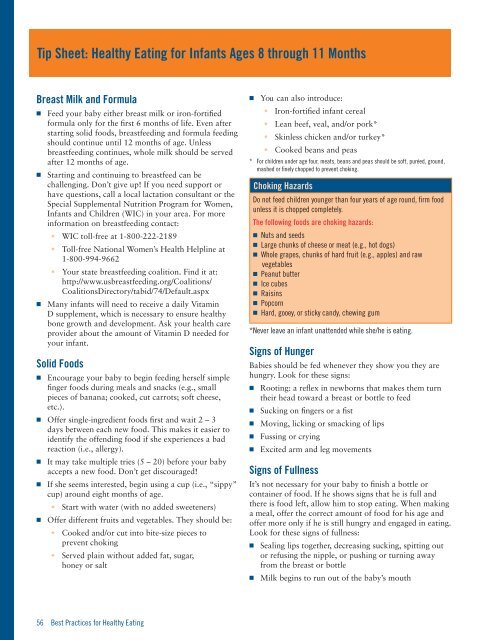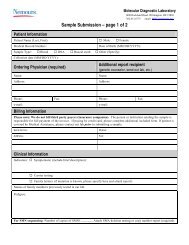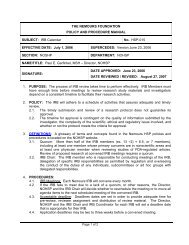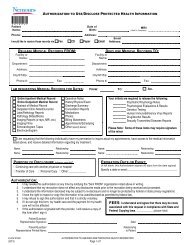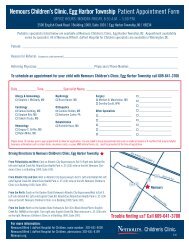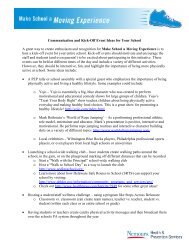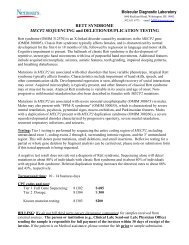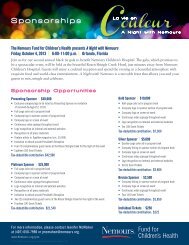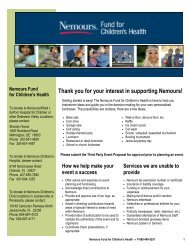Best Practices for Healthy Eating Guide - Nemours
Best Practices for Healthy Eating Guide - Nemours
Best Practices for Healthy Eating Guide - Nemours
Create successful ePaper yourself
Turn your PDF publications into a flip-book with our unique Google optimized e-Paper software.
Tip Sheet: <strong>Healthy</strong> <strong>Eating</strong> <strong>for</strong> Infants Ages 8 through 11 Months<br />
Breast Milk and Formula<br />
n Feed your baby either breast milk or iron-<strong>for</strong>tified<br />
<strong>for</strong>mula only <strong>for</strong> the first 6 months of life. Even after<br />
starting solid foods, breastfeeding and <strong>for</strong>mula feeding<br />
should continue until 12 months of age. Unless<br />
breastfeeding continues, whole milk should be served<br />
after 12 months of age.<br />
n Starting and continuing to breastfeed can be<br />
challenging. Don’t give up! If you need support or<br />
have questions, call a local lactation consultant or the<br />
Special Supplemental Nutrition Program <strong>for</strong> Women,<br />
Infants and Children (WIC) in your area. For more<br />
in<strong>for</strong>mation on breastfeeding contact:<br />
• WIC toll-free at 1-800-222-2189<br />
• Toll-free National Women’s Health Helpline at<br />
1-800-994-9662<br />
• Your state breastfeeding coalition. Find it at:<br />
http://www.usbreastfeeding.org/Coalitions/<br />
CoalitionsDirectory/tabid/74/Default.aspx<br />
n Many infants will need to receive a daily Vitamin<br />
D supplement, which is necessary to ensure healthy<br />
bone growth and development. Ask your health care<br />
provider about the amount of Vitamin D needed <strong>for</strong><br />
your infant.<br />
Solid Foods<br />
n Encourage your baby to begin feeding herself simple<br />
finger foods during meals and snacks (e.g., small<br />
pieces of banana; cooked, cut carrots; soft cheese,<br />
etc.).<br />
n Offer single-ingredient foods first and wait 2 – 3<br />
days between each new food. This makes it easier to<br />
identify the offending food if she experiences a bad<br />
reaction (i.e., allergy).<br />
n It may take multiple tries (5 – 20) be<strong>for</strong>e your baby<br />
accepts a new food. Don’t get discouraged!<br />
n If she seems interested, begin using a cup (i.e., “sippy”<br />
cup) around eight months of age.<br />
• Start with water (with no added sweeteners)<br />
n Offer different fruits and vegetables. They should be:<br />
• Cooked and/or cut into bite-size pieces to<br />
prevent choking<br />
• Served plain without added fat, sugar,<br />
honey or salt<br />
n You can also introduce:<br />
• Iron-<strong>for</strong>tified infant cereal<br />
• Lean beef, veal, and/or pork*<br />
• Skinless chicken and/or turkey*<br />
• Cooked beans and peas<br />
* For children under age four, meats, beans and peas should be soft, puréed, ground,<br />
mashed or finely chopped to prevent choking.<br />
Choking Hazards<br />
Do not feed children younger than four years of age round, firm food<br />
unless it is chopped completely.<br />
The following foods are choking hazards:<br />
n Nuts and seeds<br />
n Large chunks of cheese or meat (e.g., hot dogs)<br />
n Whole grapes, chunks of hard fruit (e.g., apples) and raw<br />
vegetables<br />
n Peanut butter<br />
n Ice cubes<br />
n Raisins<br />
n Popcorn<br />
n Hard, gooey, or sticky candy, chewing gum<br />
*Never leave an infant unattended while she/he is eating.<br />
Signs of Hunger<br />
Babies should be fed whenever they show you they are<br />
hungry. Look <strong>for</strong> these signs:<br />
n Rooting: a reflex in newborns that makes them turn<br />
their head toward a breast or bottle to feed<br />
n Sucking on fingers or a fist<br />
n Moving, licking or smacking of lips<br />
n Fussing or crying<br />
n Excited arm and leg movements<br />
Signs of Fullness<br />
It’s not necessary <strong>for</strong> your baby to finish a bottle or<br />
container of food. If he shows signs that he is full and<br />
there is food left, allow him to stop eating. When making<br />
a meal, offer the correct amount of food <strong>for</strong> his age and<br />
offer more only if he is still hungry and engaged in eating.<br />
Look <strong>for</strong> these signs of fullness:<br />
n Sealing lips together, decreasing sucking, spitting out<br />
or refusing the nipple, or pushing or turning away<br />
from the breast or bottle<br />
n Milk begins to run out of the baby’s mouth<br />
56 <strong>Best</strong> <strong>Practices</strong> <strong>for</strong> <strong>Healthy</strong> <strong>Eating</strong>


